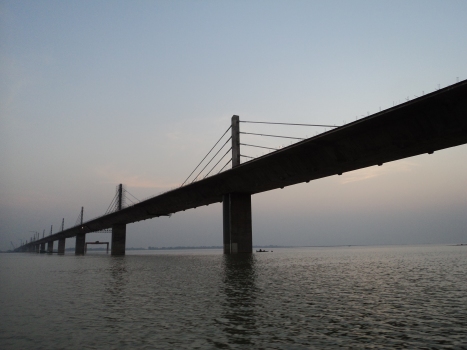General Information
| Other name(s): | Veer Kunwar Singh Setu |
|---|---|
| Completion: | 11 June 2017 |
| Status: | in use |
Project Type
| Function / usage: |
Road bridge |
|---|---|
| Structure: |
Multi-span extradosed bridge |
| Construction method: |
Balanced cantilever method |
| Material: |
Prestressed concrete bridge |
| Support conditions: |
for registered users |
| Material: |
Structurae Plus/Pro - Subscribe Now! |
| Secondary structure(s): |
Structurae Plus/Pro - Subscribe Now! |
| Material: |
Structurae Plus/Pro - Subscribe Now! |
| Secondary structure(s): |
Structurae Plus/Pro - Subscribe Now! |
Location
| Location: |
Arrah, Bihar, India Chhapra, Bihar, India |
|---|---|
| Crosses: |
|
| Coordinates: | 25° 43' 36.63" N 84° 48' 49.55" E |
Technical Information
Dimensions
| width | 24 m | |
| total length | 4 350 m | |
| number of lanes | 4 | |
| main bridge | ||
|---|---|---|
| total length | 1 920 m | |
| span lengths | 15 x 120 m | |
| number of spans | 15 | |
| deck | deck depth | 3.17 m |
| deck width | 20.50 m | |
| stay anchor spacing | 3.04 m | |
| pylons | pylon height (above deck) | 18.00 m |
| pylon height (above ground) | 37.50 m | |
Materials
| deck |
prestressed concrete
|
|---|---|
| piers |
reinforced concrete
|
| pylons |
reinforced concrete
|
Excerpt from Wikipedia
Arrah–Chhapra Bridge (Bhojpuri: आरा-छपरा सेतु) or Veer Kunwar Singh Setu (Bhojpuri: वीर कुँवर सिंह सेतु) is the longest multi-span extradosed bridge in the world with a main bridge length of 1,920 m (6,300 ft). The bridge crosses over the Ganges River in India, connecting the cities of Arrah and Chhapra in Bhojpur and Saran districts in Bihar state. The bridge provides a roadway link between the northern and southern parts of Bihar. The bridge opened for public use on 11 June 2017.
As of September 2020, it is the 9th longest bridge above water in India. The second longest extradosed bridge is Kiso-gawa bridge in Japan which is 275m long.
The project
Politician Nitish Kumar laid the foundation stone for the Arrah-Chhapra bridge in July 2010. He said that his wish was to connect the Bhojpuri-speaking districts. The bridge reduced the distance between Chhapra and Arrah from 130 km to 40 km. This has greatly reduce the distance of Arrah, Aurangabad and Bhabhua districts from Siwan, Chhapra and Gopalganj districts. People can go from South to North Bihar without going to Patna district. This bridge connects NH-19 at Doriganj in Chhapra to NH-30 at Koilwar in Arrah with a four- lane bridge.
The Rs 800 crore (US$130 million) bridge is the longest multi-span extradosed bridge in the world. The multi-span extradosed navigational section over the Ganges is 1,920m long and the bridge has a total length of 4.35 km, including the approach spans of more than 2 km. The 120m-long navigation spans are supported by five extradosed stay cables arranged in a single-plane harp configuration, whereas the approach spans are simply-supported. The navigation spans and 2 km of the approach spans are composed of single-cell precast concrete box girders, while the remaining 0.35 km of approach spans are cast-in-place. The total length of approach road on either side of the bridge is 17 km. In September 2015, seven people were killed after a crane collapsed at the bridge construction site.
Bridges across the Ganges in Bihar
The Ganges divides the state of Bihar in two parts. The river makes communication between the two parts difficult.
The first effort to bridge the gap was Rajendra Setu in 1959. The next bridge across the Ganges in Bihar was the 5,575-metre (18,291 ft) Mahatma Gandhi Setu, the longest bridge in India at the time of its commissioning in 1982. It was followed by Vikramshila Setu near Bhagalpur. The fourth bridge across the Ganges in the state is the Digha–Sonpur bridge.
Munger Ganga Bridge is also under construction. A 5.575-kilometre-long (3.464 mi) bridge Bakhtiyarpur-Tajpur Bridge is under construction which will connect Bakhtiyarpur and Tajpur.
Arrah–Chhapra Bridge across the Ganges connects Arrah and Chhapra. A road bridge parallel to the existing rail and road bridge, Rajendra Setu, has also been planned.
Text imported from Wikipedia article "Arrah–Chhapra Bridge" and modified on October 5, 2020 according to the CC-BY-SA 4.0 International license.
Participants
Relevant Web Sites
Relevant Publications
- (2018): Crossing the Ganges: The World’s Longest Extradosed Bridge. Presented at: IABSE Symposium: Tomorrow’s Megastructures, Nantes, France, 19-21 September 2018, pp. S12-49.
- (2017): Design and Erection of the Arrah-Chhapra Bridge. Presented at: IABSE Symposium: Engineering the Future, Vancouver, Canada, 21-23 September 2017, pp. 540-547.
- (2018): Design of Multi-Span Extradose Bridges in India: Two Case Studies. Presented at: IABSE Symposium: Tomorrow’s Megastructures, Nantes, France, 19-21 September 2018, pp. S12-57.
- About this
data sheet - Structure-ID
20070516 - Published on:
21/01/2016 - Last updated on:
16/10/2017





